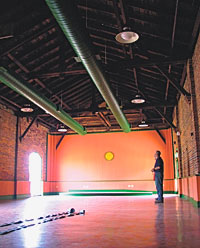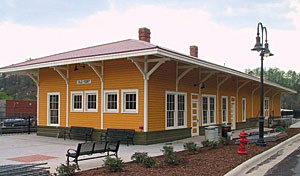
photo by Jodi Ford
Something old, something new: The train station in Marion — restored for $1.78 million — will be dedicated on May 20. The renovation includes outdoor and indoor stages, upgraded restrooms, a kitchen area and other amenities. The future of passenger rail service, however, remains murky.
|
The old train station in Marion is a cavernous red-brick building that bespeaks a vanished world. For decades, it stood empty, left to the incursions of the weather and the occasional homeless person looking for a place to bed down. But on May 20 (see end note), N.C. Department of Transportation officials and local leaders will celebrate the reopening of renovated stations in Marion and neighboring Old Fort — the latest in a series of such projects.
In 2001, the DOT’s Railroad Division adopted a plan to bring passenger-rail service back to Western North Carolina. As a first step, the plan calls for restoring six historic depots in WNC. Federal funds covered 80 percent of the cost for the Marion ($1.78 million) and Old Fort ($1.49 million) projects, with the DOT and the cities themselves supplying the rest. And though the resumption of passenger service is hardly imminent, the buildings’ historic significance and potential for other uses in the interim (Marion’s depot, for instance, sits a mere two blocks from downtown) are driving the renovation effort.
In the mid- and late 1800s, the railroad line was a vital artery in WNC, linking towns such as Statesville, Hickory and Morganton before coming up against what was then a formidable barrier: the Blue Ridge escarpment. Initially, rail service ended at Old Fort, but a monumental engineering effort employing multiple switchbacks and tunnels eventually breached the Continental Divide, bringing the railroad to Asheville in 1880. For the next half-century or so, both freight and passenger rail were critical to the city’s growth. But as cars grew in popularity and the road network expanded, train traffic dwindled. Passenger-rail service ended in the 1970s, and many of the region’s passenger depots were subsequently abandoned or torn down.
Peeling back the past
According to the DOT, the Marion station dates to the mid- to late 1800s. But the historic record is murky, and graffiti found inside shows dates ranging as far back as 1810, reports Construction Coordinator Jeff Ashton of Progressive Contracting, the lead company on both restorations. Over the decades, the main section of the depot was expanded several times. A different-colored brick reveals a 1970s-era addition; a 1957 remodel is glaringly obvious, with all the subtlety of a drive-in diner from the period.
“At that time, preservation wasn’t even a concept,” notes Ashton, who’s been restoring historic structures for 24 years. “It was just ‘tear down the old buildings.'”
Time has not been the only contributor to the depot’s slow erosion, though. The trains themselves (which once came through at the rate of 10 a day) also took their toll as they blew by at 60 mph, says Ashton, literally blasting away the mortar on the lower portions of the brick walls. The interior, however, was mostly in good shape, with exposed brick, ceiling beams and signs on the walls indicating where cargo was to be dropped.
Meticulous care was taken to match the original materials where possible. To restore the entrances, Ashton had to find brick that matched not only the color and texture of the original but also the strength. After an eight-month process that included consulting with the Raleigh-based architectural firm Hagersmith Design, the builders finally found a house in Leicester, made of similar brick, that was being torn down. As a result, the restoration work is detectable only up close.
Still, from a purist’s point of view, the project as a whole doesn’t qualify as true historic restoration, notes Ashton. Like other towns reviving their depots, Marion wanted to get plenty of use out of the building without waiting for the advent of passenger rail. So the renovation also included landscaping, a fountain and an outdoor sculpture made of huge sections of rail. Outdoor and indoor stages will provide performance spaces, and a wedding reception is already scheduled to take place in the new park, Ashton reports. Upgraded restrooms, a kitchen area and other amenities make the renovated station a unique asset for the town.
Portal to the mountains

photo by Jodi Ford
All aboard for Old Fort: The renovated Old Fort train station features a ticket booth and waiting area returned to historically accurate form, with such modern concessions as restrooms and handicapped-accessible ramps.
|
Old Fort’s depot sits right at the entrance to town. Impossible to miss, the bright-yellow building is as much of a local landmark as the giant arrowhead monument that sits next to it. And unlike the Marion station, this one has remained in use, housing the Mountain Gateway Museum (which documents the massive push to extend the rail line over the Blue Ridge) and the Chamber of Commerce. As a result, the building was relatively well-preserved, says Site Superintendent Tom Willis, and much of the restoration involved removing walls and other added elements concealing the original structure. As in Marion, some walls bore historic graffiti (now left exposed to view). Inside, the ticket booth and waiting area have been returned to historically accurate form, with such modern concessions as restrooms and handicapped-accessible ramps.
“We’ve tried to maintain the historic charm … to maintain the period aspect of the building,” Willis notes. The Old Fort station was built in 1896 and expanded in 1916; the restoration work has taken a little more than a year.
Brevard architect Ellen Harris, a veteran of other historic projects in WNC, was brought in to do the design work. Her challenge was figuring out which parts of the building were original and which had been added later. But though she consulted old photos, written documents and railroad archives, says Harris, there wasn’t much to go on.
“We tried to identify the significant parts of the building that needed to be kept or even reproduced,” she explains.
Standing by a window looking out at the tracks, or sitting on a period bench, it’s easy to imagine a locomotive hissing and snorting outside, waiting for passengers to board.
But Old Fort residents say they’ve seen how slowly money trickles out of Raleigh into WNC, and they’re not holding their breath on the return of passenger trains to the region, says museum staffer Louise Byron. Still, folks are excited about the renovated station, whose period flavor — complete with ticket window standing open, apparently ready for use — will enhance the museum’s appeal.
Rolling into the future
There’s a lot more that must be done before passenger trains once again rumble through these historic stations. At this point, even estimates on the cost of upgrading track, pouring footers at the stations, and other essential elements remain rough, and a DOT spokeswoman declined even to speculate on a time line.
DOT officials have been talking with Asheville City Council members for years about where to build a new Asheville train station. A historic depot in Biltmore Village was restored privately and is now a restaurant; another, larger depot in what’s now the River District was torn down years ago.
According to Mayor Charles Worley, the DOT is still searching for a site. In March 2004, City Council approved up to $141,883 in matching funds for the future depot.
Passenger service now stops at Salisbury, which DOT officials say is a likely location for an Asheville/Raleigh transfer. And as the agency is fond of pointing out, Asheville tops the list of Amtrak’s most requested destinations not currently served. Environmentalists, meanwhile, are supporting train travel as an alternative to building more highways to accommodate still more cars — already a prime contributor to the region’s substantial air-quality woes.
And though the impact of passenger rail’s return to the region remains to be seen, at least a few towns — Old Fort and Marion among them — will be ready when it comes.
The public is invited to attend the May 20 dedications. The Old Fort ceremony will be held at 10 a.m., followed by Marion at 11:30 a.m. For more information on the passenger-rail project, check the DOT Rail Division’s Web site (www.bytrain.org).
[Brian Postelle is a regular contributor to Mountain Xpress.]



Before you comment
The comments section is here to provide a platform for civil dialogue on the issues we face together as a local community. Xpress is committed to offering this platform for all voices, but when the tone of the discussion gets nasty or strays off topic, we believe many people choose not to participate. Xpress editors are determined to moderate comments to ensure a constructive interchange is maintained. All comments judged not to be in keeping with the spirit of civil discourse will be removed and repeat violators will be banned. See here for our terms of service. Thank you for being part of this effort to promote respectful discussion.